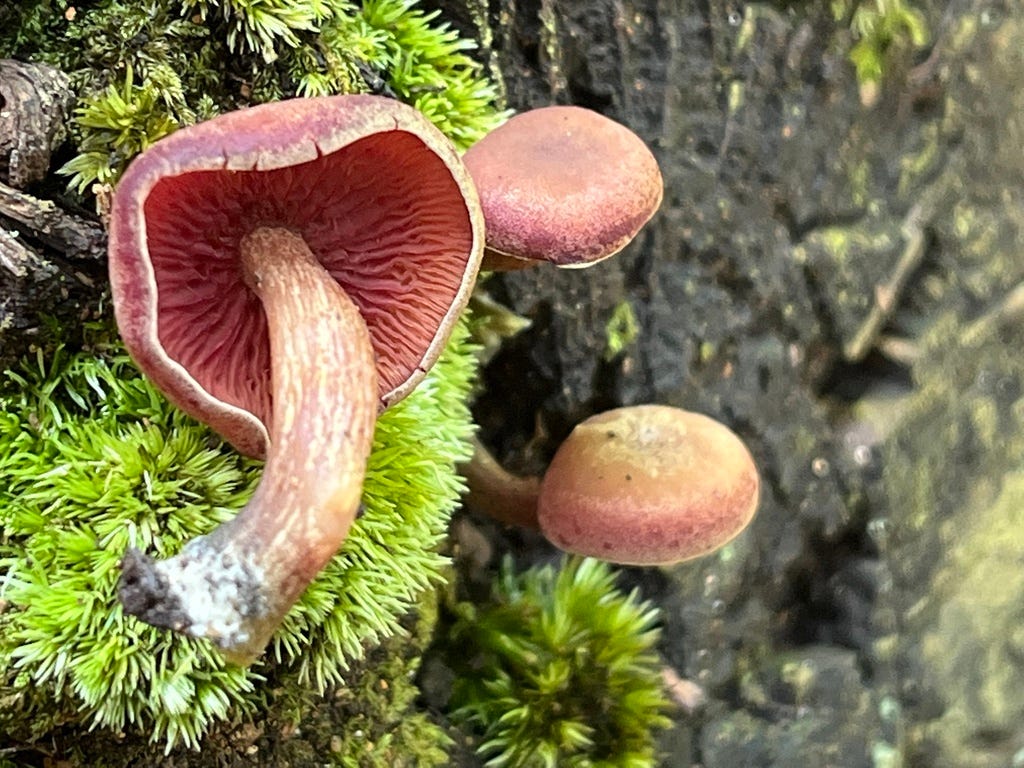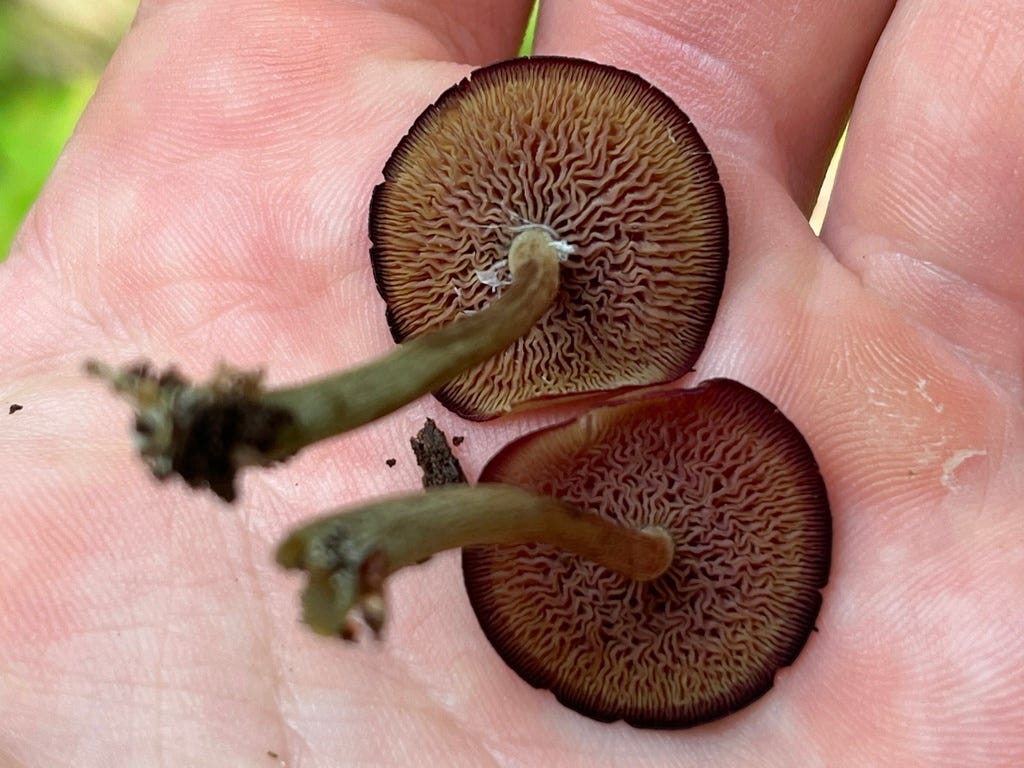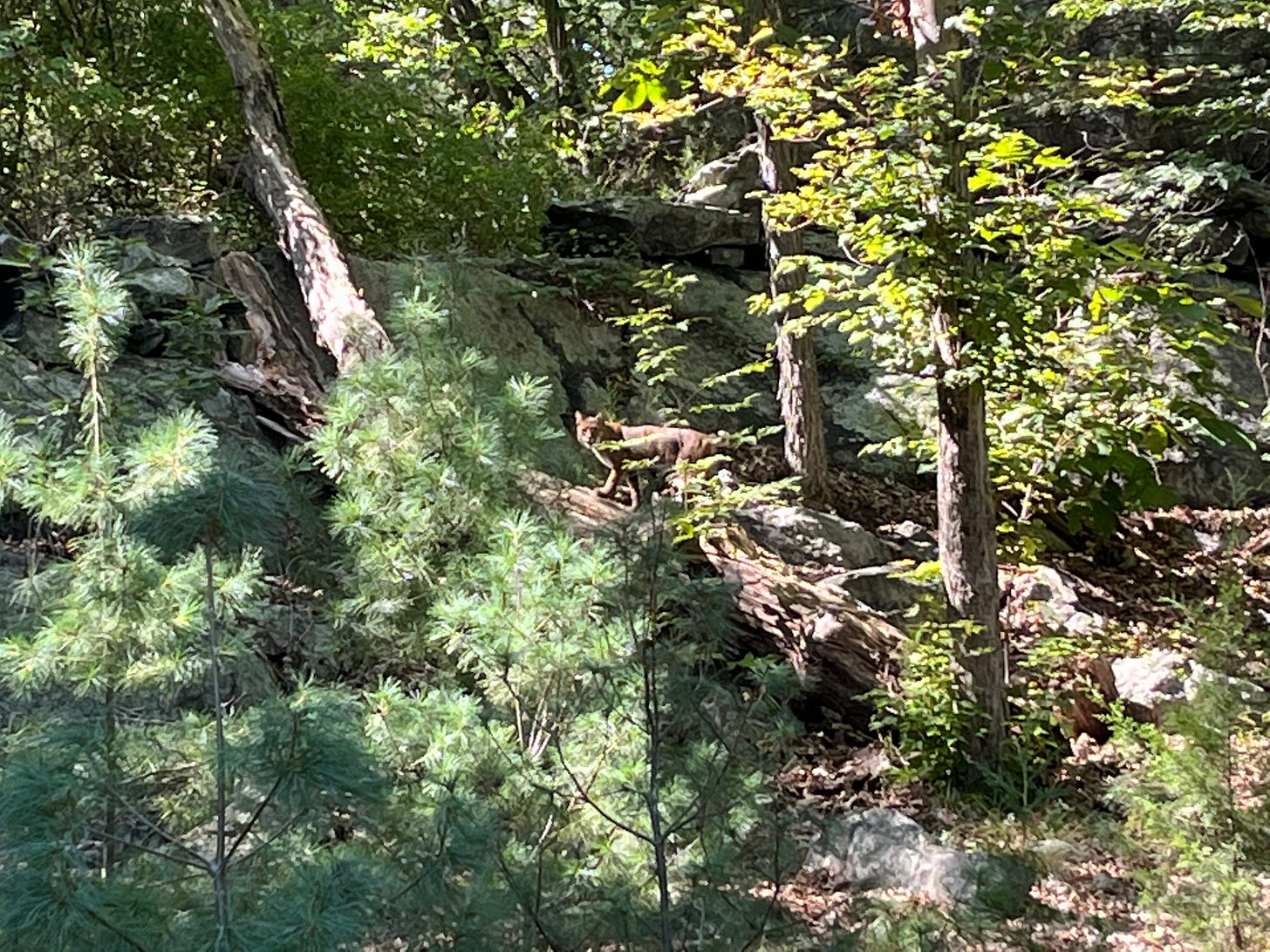Hey gang,
Last few days of August, soak it up. This week we’re looking at the Purple-edged Lute (Callistosporium purpureomarginatum). While not the largest mushroom in stature, the fungus more than makes up for it with a scientific name 33 letters long - definitely one of the longest we’ve seen. I found this uncommon mushroom growing last Monday in Manitou on old, decaying oak.
The fungus was only just described scientifically by humans in 1996 so there isn’t too much available information on this mauve mystery, but to supplement that we’ll also look at a slew of fungal festivities that will help ring in the best mushroom (and just in general) season of the year. If you read all the way to the bottom I'll include some sweet pictures of a bobcat I saw at Manitou this week :)
Fun Facts
This specimen had been collected a few times in the 90s, most notably by Raymond Fatto in 1994 and 1995,. Fatto conducted a species survey over eleven years in the University of Rutgers Hutcheson Memorial Forest located in Somerset County, NJ. It was apparent after a few encounters that it was not just a purple form of the more common Olive Lute (Callistosporium luteo-olivaceum) and was a unique species. Alan Bessette and Ray Fatto published a paper in 1996 that officially introduced the species to the scientific world (Reference 4).
The etymology of Callistosporium is difficult to decipher. The suffix -sporium refers to the spores, which are white, but what the prefix suggests of these spores is hard to determine. Callisto- may (hopefully) refer to Greek mythology where Callisto was a nymph of Artemis, the Goddess of wilderness, hunting, and other natural elements. On my better days at work I, too, identify as a nymph of Artemis.
The mythology of Callisto is a twisted, scandalous tale. Allegedly, Callisto was turned into a bear by Artemis for having illicit relations with Zeus. Some stories very but she was either killed by her son (in a hunt, the irony) or, just before she was to be killed, Zeus cast her into the sky. Regardless of how she got there, she now lives out the rest of eternity as the constellation Ursa Major.
The species epithet purpureomarginatum refers to the distinct, dark purple margins of the cap on older specimens. It should also be noted that all species in the genus Callistosporium change color as they get old and/or dry.

Ecology
The fungus is saprobic, digesting the wood of long-dead oak trees. It’s good to note that the trees are already well-decayed as this would suggest the fungus is a secondary decomposer of oaks. The full range of the fungus isn’t entirely known, but as of right now it’s almost exclusively been seen in northeastern North America growing from July through September. A similar species, Chromosera cyanophylla, grows on dead hemlock (Tsugae canadensis) and not oak.

Another interesting feature about the fungus as a decomposer is that it creates a brown rot in wood. The majority of fungi - close to 90% - create a white rot in wood. The difference between white rot and brown rot lies in the fungus’s dietary preferences. Brown rot fungi prefer to digest the cellulose in the wood while white rot fungi prefer to digest the lignin. This also creates a noticeable texture difference in the wood where a white rot is well, white, but also punky, soft, and fibrous. Brown rot is firmer and breaks off in cubical chunks.
Mycological Happenings
Three out of the four weekends in September I’ll be at a mushroom camp of one sort or another so we’ll continue to collect plenty of fungal content to sustain us through the winter. There are a bunch of events to help you celebrate the climax of mushroom season in the northeast.
The weekend of 9/8-10 we’ve got the fall Friends of Fungi retreat at Menla in Phoenicia, NY. Space is still available and you can get more information here. It’s a great jumping off point for folks interested in mushrooms and you’ll leave with experience in cultivation, tincture making, field identification, biotech applications, and more. I participated two and a half years ago and now am fortunate to help cultivate this foundational experience for other myconauts.
The following weekend is the Northeast Mycological Federation Foray at Soyuzivka Heritage Center in Kerhonkson, NY. I hadn’t publicly announced it yet but I was fortunate enough to be a co-recipient of the Mid-Hudson Mycological Association’s Gary Lincoff Memorial Scholarship which I will use to attend this foray. I never met Gary but I did begin my mycological odyssey in Central Park, his long-time haunt, so I always like to think we interacted with some of the same mycelium just a few years apart.
The last weekend of the month, 9/29-10/1, features the first weekend-long For the Love of Fungi Festival up in New Paltz, NY. I’ll help kick off the festival that Friday afternoon with a presentation on Lesser-Known Medicinal Mushrooms of the Northeast. I’m also co-leading a foray on Saturday afternoon. There will be a lot of sharp mycologists and fascinating people to learn from so come for a day or come for the weekend - whatever’s clever. Hope to see you there.
Finally, I’ll also be presenting on Lichen of Central Park at the New York Mycological Society’s Fungus Festival on Randall’s Island on 10/15. Last year we talked about Mushrooms of Central Park and now we’re going to take a closer look at some of the less appreciated but perhaps even more fascinating fungi, the lichens.
Full moon at 9:36pm on Wednesday. This is the second of the month which makes it a Blue Moon. Don’t be afraid to jot down a reminder so you don’t forget,
Aubrey
BOBCAT PICTURES
First time I’d ever seen one and I saw that cat twice in one day. Very handsome, but not more than twice the size of a house cat.
References:
Kuo, M. (2019, September). Callistosporium purpureomarginatum. Retrieved from the MushroomExpert.Com Web site: http://www.mushroomexpert.com/callistosporium_purpureomarginatum.html
https://www.inaturalist.org/taxa/500027-Callistosporium-purpureomarginatum
http://www.cybertruffle.org.uk/cyberliber/59575/0060/0125.htm











